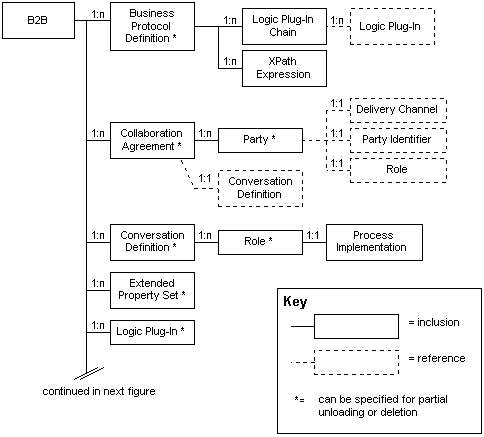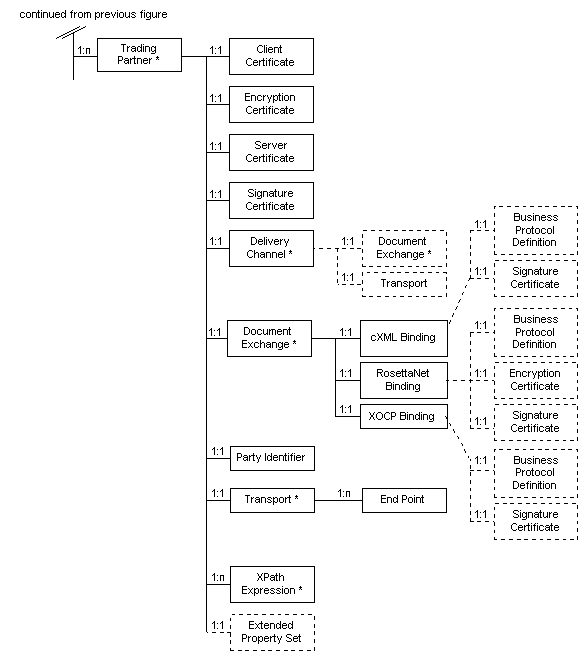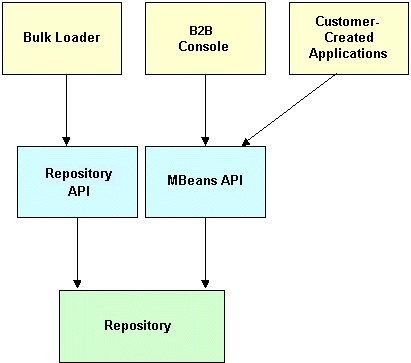

| Download Docs | Site Map | Glossary | |
|
|
|||
| bea.com | products | dev2dev | support | askBEA |
 |
 |
|
|||||||
| e-docs > WebLogic Platform > WebLogic Integration > B2B Topics > Administering B2B > Working with the Repository |
|
Administering B2B
|
Working with the Repository
The following sections describe the WebLogic Integration repository:
Note: The XOCP and cXML protocols are deprecated as of this release of WebLogic Integration. For information about the features that are replacing XOCP and cXML, see the BEA WebLogic Integration Release Notes.
Understanding the Repository
The WebLogic Integration repository is the database that stores the information required by WebLogic Integration. The repository consists of:
B2B Configuration Elements
The following two figures show the relationships among the B2B configuration elements in the repository. For information about configuring the repository data elements, see Configuration Requirements.
Figure 6-1 Elements in the Repository (Part 1)
The following figure is a continuation of the previous figure. Figure 6-2 Elements in the Repository (Part 2)
In the figures, solid lines represent inclusion and dashed lines represent reference. When you remove an element from the repository, the following events occur:
For example, if you remove a collaboration agreement, the referenced conversation definition remains.
You cannot, however, remove an element if another element still has a reference to that element. You must modify the reference to point to another element of the same type or remove the element with the reference. For example, you cannot remove a trading partner from the repository if that trading partner has an indirect reference from a collaboration agreement. This indirect reference from a collaboration agreement to a trading partner is shown in Figure 6-3. In Figure 6-3, a collaboration agreement has an inclusive relationship with a party and that party has a reference to a party identifier. A trading partner has an inclusive relationship with a party identifier. Therefore, to remove a trading partner from the repository, you must either remove the collaboration agreement that is referencing the party identifier or change the reference from the party of the collaboration agreement to a different party identifier.
Figure 6-3 Indirect Reference from Collaboration Agreement to Trading Partner
There are other instances of elements that cannot be removed if another element has a reference to it. For different relationships between repository elements, see Figure 6-1 and Figure 6-2. For example, you cannot remove a conversation definition until you first modify the reference to it in an associated collaboration agreement. That is, either you must change the reference in the collaboration agreement to point to a different conversation definition, or you must remove the conversation definition before removing the associated conversation agreement. The following table provides an overview of the elements in the repository.
Managing the B2B Configuration Information in the Repository
The following figure illustrates the methods you can use to manage the information in the repository.
Figure 6-4 Managing the Information in the Repository
As this figure illustrates, when you update information through the B2B Console or a custom management application, the repository is accessed by means of the MBeans API. The Bulk Loader employs a low-level API to handle database operations. The MBeans API enables you to update the repository dynamically at run time. That is, database updates can occur while the B2B engine is running. The Bulk Loader, on the other hand, requires B2B engine shutdown. Additional information about each of these methods of updating the B2B configuration elements stored in the repository can be found in the following documents:

|

|

|